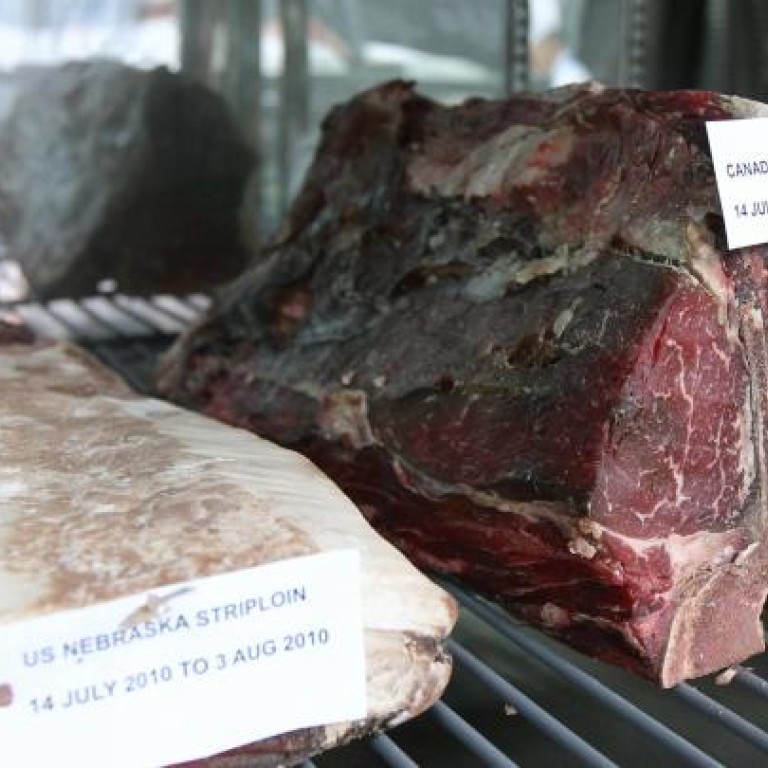
Butcher introduces bespoke dry-aged beef
Butcher offers bespoke dry-ageing service to discerning customers
Hong Kong food fanatics are familiar with choosing rib-eye or sirloin, medium-well or rare. But what about wet- or dry-aged? The soon-to open Butcher's Club, a butcher's shop combined with a private kitchen and catering company, will be offering in-house, dry-aged prime black Angus beef.
Dry-aged beef isn't common in Hong Kong. In North America, any steakhouse worth its salt has dry-aged beef on the menu.
The Steakhouse Winebar + Grill at the InterContinental hotel has a daily rotation of dry-aged prime beef, the Grand Hyatt Hong Kong's Steakhouse has a small selection of bone-in dry-aged beef and the Blue Butcher has grain-fed wagyu dry-aged in house.
Fans say once you've tried dry-aged beef, you can't go back. Because the beef is more expensive, given the time and care it takes to produce, Hong Kong and its gastronomic elite seems a prime market, and it was with this in mind that Jonathan Glover founded The Butcher's Club.
"It's been a dream of mine for 10 years," he says.
Customers buy a hunk of beef, called a sub-primal, and entrust it to dry-age specialist chef Aarik Persaud. Thirty to 45 days later, he'll make the "Your beef is ready" call and they can pick it up or have it delivered to cook and eat at home, or take up to nine friends to The Butcher's Club's private kitchen and have it all done for them.
Persaud is from Toronto, where he worked in dry-ageing for restaurateur and chef Jason Rosso. "In New York or Toronto, a lot of restaurants have meat lockers in the centre to show them off, like wine. Canada breeds a lot of cattle, so beef is a huge part of our diet, and the dry-ageing trend is travelling." Wet-ageing (vacuum-sealing beef in a bag) was invented in the 1960s. The beef stays in contact with its blood, and there is no shrinkage due to loss of moisture. The huge cuts in cost and time mean that only some butchers carry on the traditional dry-ageing. Persaud says dry-ageing had its North American renaissance 10 to 15 years ago.
The Butcher's Club dry-age room is far more than a locker. The 100 sq ft space has room for 250 sub-primals, each between 4kg and 5kg (enough for about 12-14 steaks). The process takes place in controlled conditions.
"The dry-age room is kept at a constant 70 per cent humidity, the temperature is between zero and two degrees Celsius, and there is rapid air circulation," says Persaud. "The sub-primals are wrapped in muslin cloth, rewrapped and turned daily."
The enzymes in the meat break down the connective tissue, increasing the flavour and tenderness. David Hoffman is a South African who has lived in Hong Kong for 11 years. His mission is to eat at every steakhouse in the city; his favourite is was Morton's, even though it doesn't serve
dry-aged steak.
"I got a couple of cuts [from Glover], and the rest was history," he says. "It's the flavour and tenderness, that's where the difference is. When you cut through the meat and taste it for the first time, there's a lot more flavour, and it is so soft."
Every sub-primal is different, so how does Persaud know it's done?
"Through a mixture of the senses," he says. "By touch [it should feel like a medium-rare steak]; by sight [there should be a good crust]; by sound [there should be a bready, hollow sound when you tap it].
We weigh it, and once it has lost about 15 per cent, it's ready."
"We're celebrating a birthday at The Butcher's Club in May, and I'm sure we'll be doing a lot more there," says Hoffman. "We're always looking for different places, and it's hard in Hong Kong to find comparable steaks to those in South Africa."
The sub-primals cost HK$1,200 to HK$1,300 per piece, with a 25 per cent surcharge for the ageing, but when divided up into 10 or more steaks, that's a good price for dry-aged perfection.
A typical evening startswith a seafood platter and end with cheese.
The steak course is served with three-time duck fat fried chips, a green salad with mustards, sauces and smoked salts.
It's bespoke but simple.
